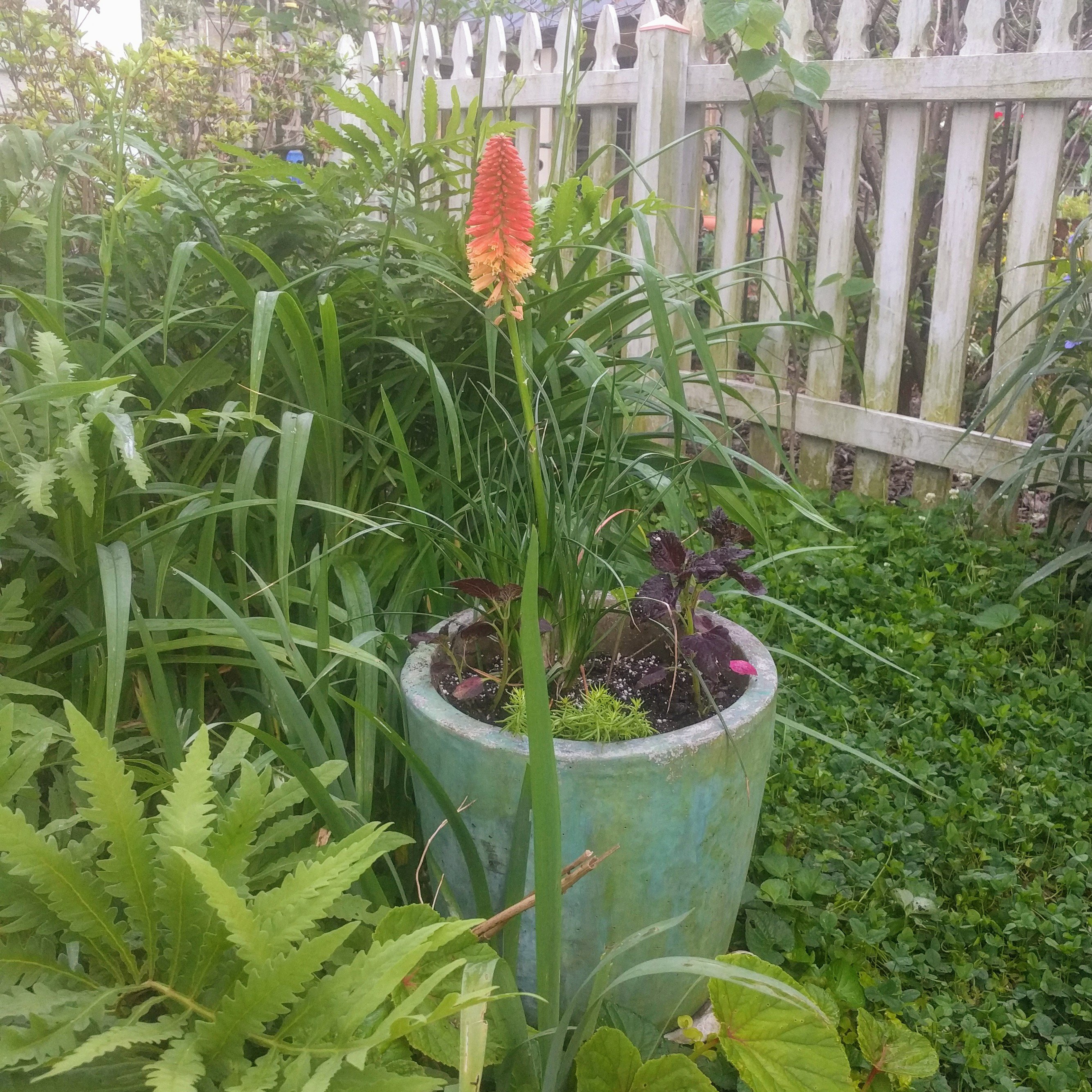Many hell strips in my old neighborhood are too steep to walk on anyway. These neighbors made theirs into a high-contrast medley of dark violet Louisiana iris and bright chartreuse lysimachia.


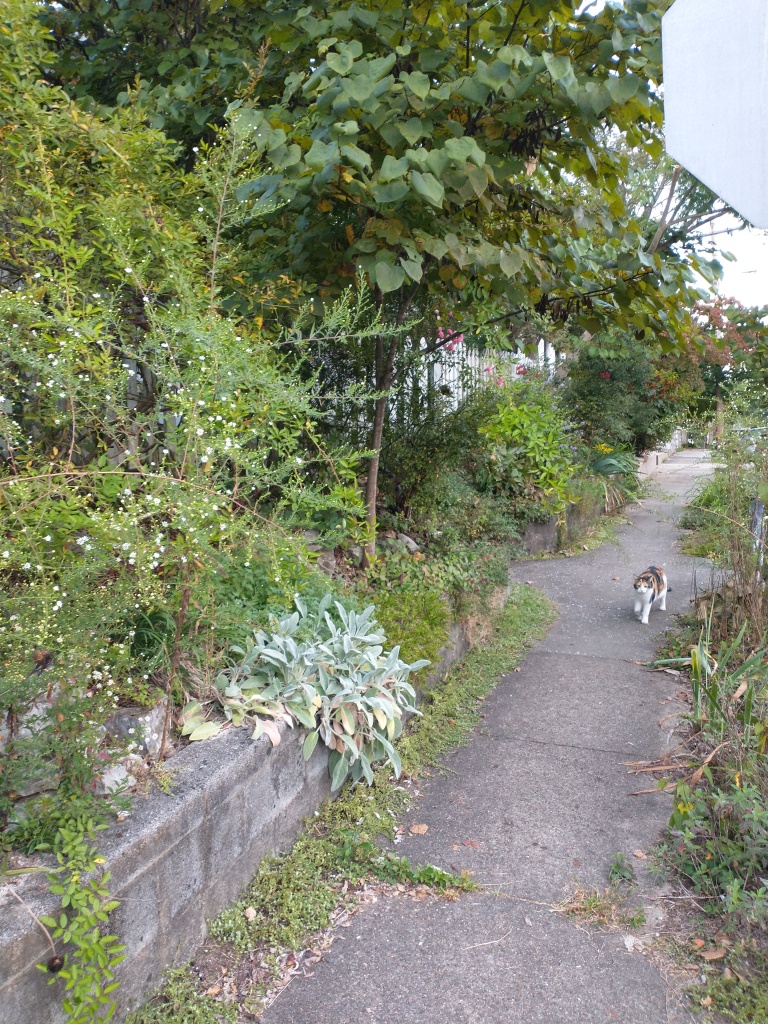
I love pollinators, so I love the native asters that spring up everywhere I don’t rip them out. Plus, the asters are so graceful and airy I just cheer them on. They’re the last things to bloom, so the honeybees, carpenter bees, and every other pollinator are on them until they go to seed.

Ditto the native autumn clematis. Yes, they’re rampant, they’re elbowing less energetic plants out of their way, but they are also beloved of pollinators.
I know some people view such enthusiasm skeptically, so I was preemptively apologizing to my next door neighbor. She cut me off and relayed one of the best compliments I’ve received on my garden: “My granddaughter calls it ‘the fairy house.'”
Well, then!
I’m not going to change a thing.
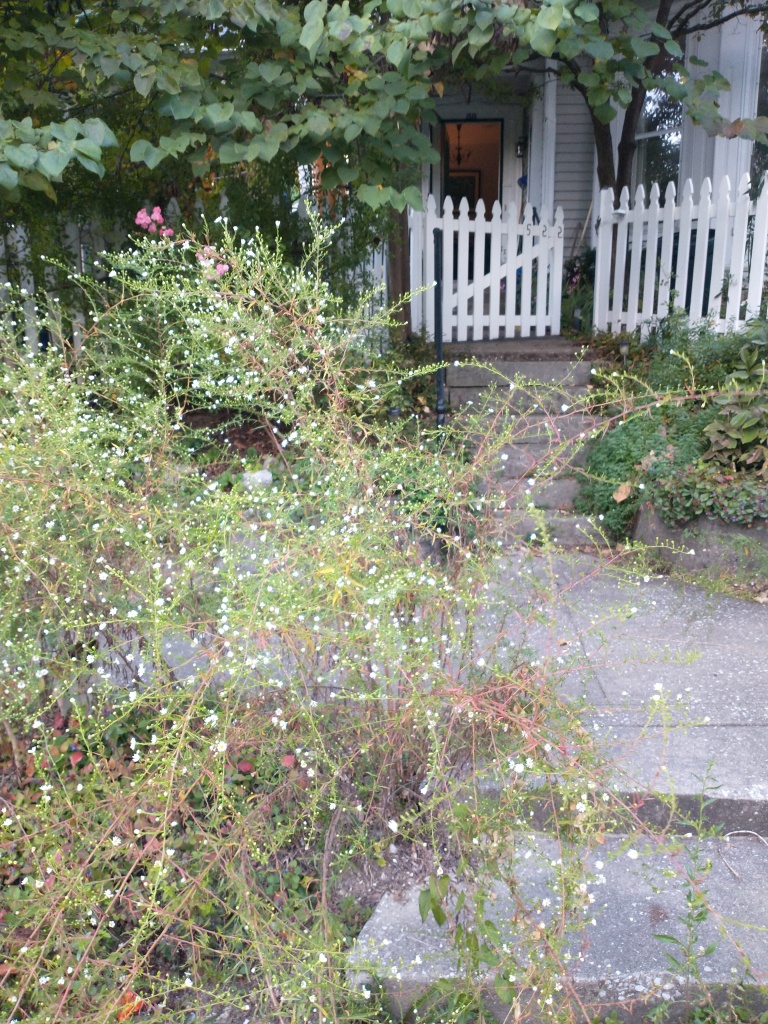

We got the well-watered summer and dryish fall we needed here in the Bluegrass area to yield the best fall foliage. I don’t usually think to plant oakleaf hydrangea for fall color, but this one of my neighbor’s (above) is gorgeous right now. One more reason to plant the iron-tough old favorite.

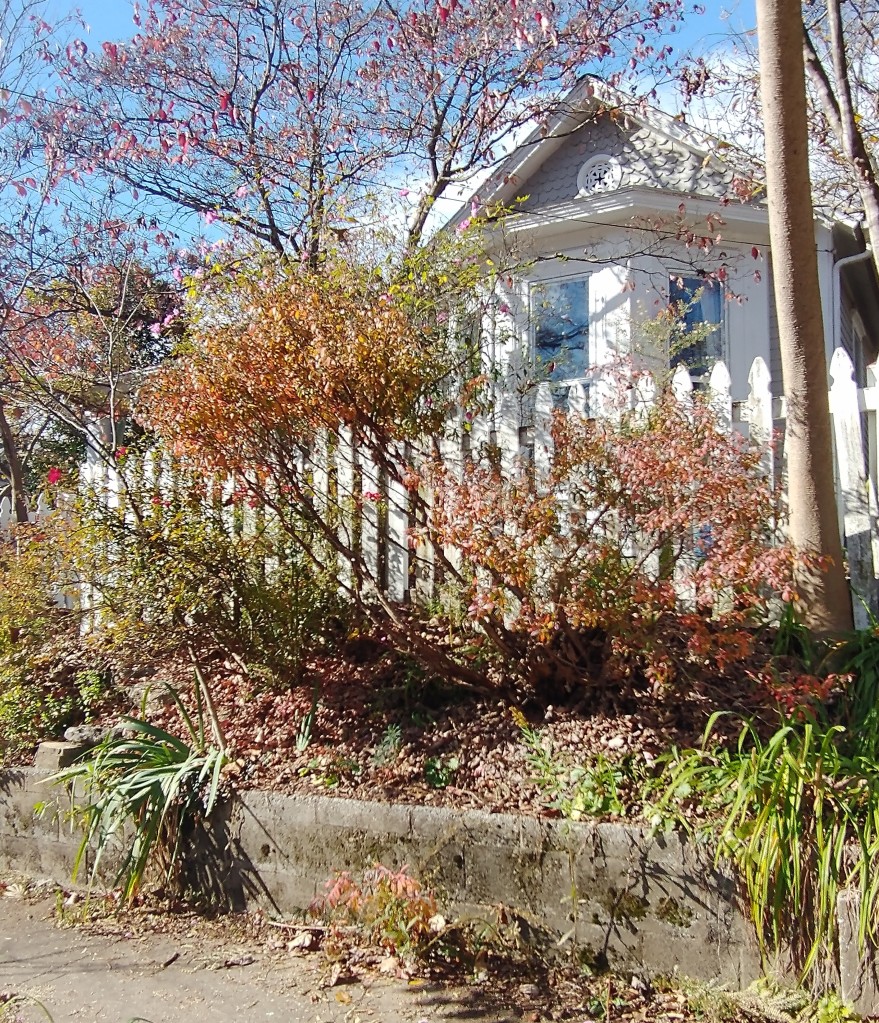

This picture demonstrates a prime reason you need to plant own-root roses: the blooms you see are NOT blooms of the Peace rose. They’re the blooms of its rootstock, Dr. Huey. The top of the grafted plant was most likely killed by cold weather. Here’s what the Peace rose looks like.

By Hobbykafe – Own work, CC BY-SA 3.0, https://commons.wikimedia.org/w/index.php?curid=10054325
The Peace rose has a famous backstory dating to before WWII. Check it out here:
https://en.wikipedia.org/wiki/Rosa_Peace
What’s happened is that Peace was grafted onto easy-to-root Dr. Huey plants, but then the cold weather killed the top of the plant, and the rootstock that was left sprang up and bloomed. Every spring here in Zone 6, Dr. Huey is blooming everywhere. I like the maroon flowers and gold stamens, but the rose is a once-bloomer, and the plant itself is not great looking without blooms.
To make mass production of plants easier, growers root the variety of rose that’s easiest to get rooted. They then graft the more finicky variety, such as Peace, onto the already-rooted plants, and sell those.
Not only will the top of a grafted plant often die, leaving you with Dr. Huey, but grafted roses also don’t thrive as well or live as long. After only a few years, a grafted plant will decline and die from a kind of tissue rejection. On the other hand, a rose on its own roots will live as long as a tree.
I’ve listed my go-to sources here: Sources for excellent own-root roses
Lazy gardeners, plant own-root, for a rose that will thrive for a long, long time.
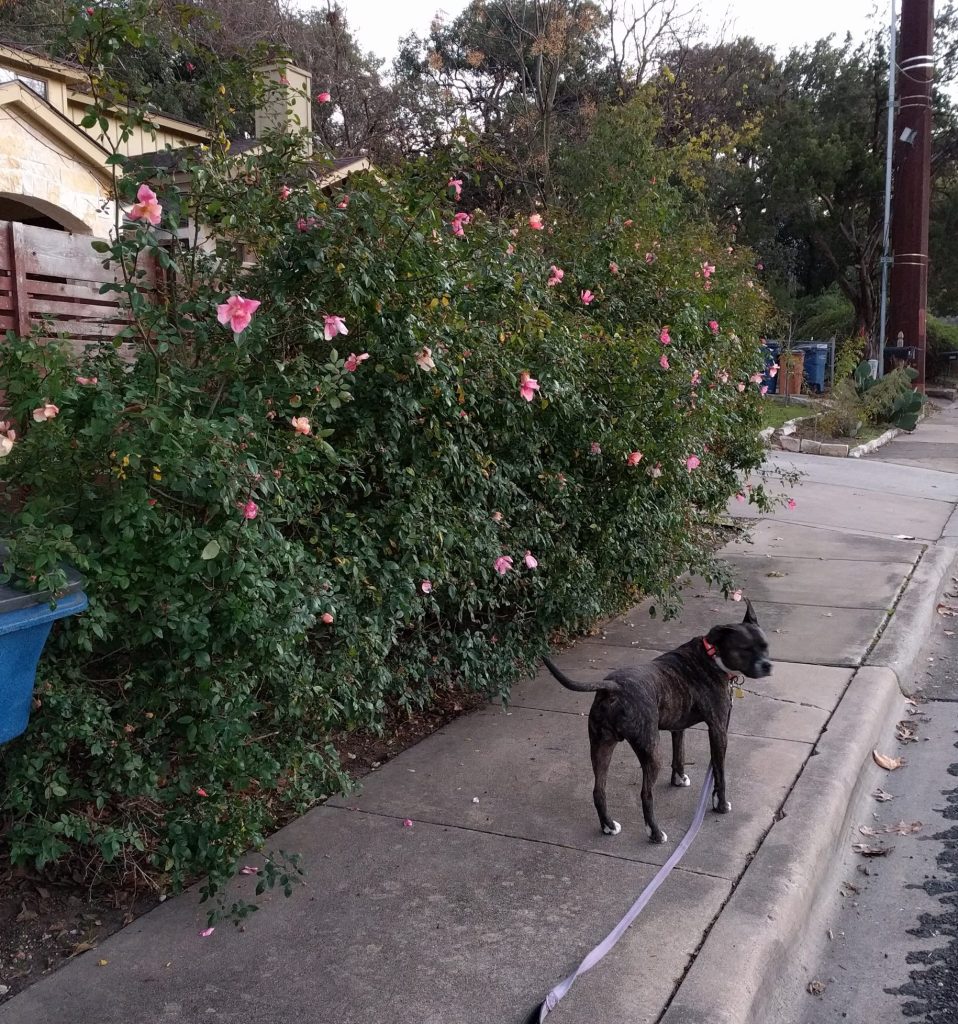
And why change something that works 24/7/365, in all kinds of weather?
The gardeners of Austin rely on Mutabilis, another single China rose, to look good with minimal care. Here is a dense six-foot hedge of it, blooming enthusiastically, January 3, 2020. This one smells magical.
The name comes from the fact that the blooms start out yellow and then get more and more fuchsia as they age. This darkening in the sun is a characteristic of China roses.

The plant is a dense tangle of petite twigs. The blossoms are fire-engine red with some streaks of white. I associate these characteristics with China rose heritage.
There was no detectable scent, and the abundant blue-green foliage is very tiny, which makes me suspect Martha Gonzales.
What do you think?

Down in Zone 8, in January, everything is brighter, milder, and cheerier.
Yesterday, after some pretty deep midwinter malaise, to the level of existential crisis, the clouds cleared and the sun came through just as it was about to set. Everything felt very, very different. In a good, good way.
We came down for New Year’s on a whim. In January 2020 in Zone 8 Austin, there are roses blooming, many in full bloom. I’m going to post pics here and guess what varieties they are.

You know you’ve REALLY succeeded as a gardener when you receive a citation that you’re violating local code ordinances. I’m not kidding.
Think about it: Being cited for your plants’ thriving SO well that they’re enthusiastically spilling their abundance of flowers and foliage onto the sidewalks or into the view of drivers trying to pull out into traffic is a merit badge certifying “Damn, you’re getting good at this.”
I did not at first understand this. The first time I was cited, in Lexington, for planting obstructing the sidewalk or some such, I freaked out. If stuff I’d planted was in somebody’s way, why didn’t he — if he was terrified of meeting the ogress who’d planted such monstrous, thorny, fragrant-flower-bearing brambles — why did he not just leave a note on my porch? It was only ten steps from the sidewalk.
I looked at my neighbors suspiciously, trying to guess who might have dropped a dime on me to the local code enforcement officers.
Also, remembering how Grandma, in her eighties, with her three artificial hips [one replaced in one of the earliest hip replacement operations I knew about, then later the other hip replaced as well, then the first replacement revised and the eroded bone built back up using her own bone and epoxy so that her legs were once again the same length] used to walk three miles a day using a rolling cart for stability, the LAST thing I wanted to do was to block somebody else’s grandma from using the sidewalk.
Bob, on the other hand, was delighted and entertained. He explained to me how the citation was a merit badge, how some people can’t stand to see anything enthusiastically overflowing beyond the boundaries of its box, how anybody who would call the city rather than talk to us or leave a note on our door, was a little — did not share our value of life and health and rampant enthusiasm, let us say, anyway.
Oh.
In that case. . . .
So when my neighbor and gardening role model [and writer about the cultures of growing things — check out her book, Row by Row] Kate Black was cited by code enforcement for “flowers spilling over the sidewalk”!!! It’s almost poetic, and she was having the same paranoia attack I had had the first time I was cited, I could explain to her what that actually meant.
I’m proud to say I’ve been cited several times since then, both for my Lexington and my Frankfort gardens. (All the code enforcement officers I’ve ever spoken with in both places are absolutely the nicest people, BTW. Many of them are gardeners whom I’ve had great conversations with). The big rose in the photo here, an old spring bloomer common in this area, was the object of my most recent citation badge of honor. It’s near a street corner. Apparently, for the month it was blooming, drivers in the neighborhood had to slowly inch up beyond it to check for oncoming traffic before they pulled onto the cross street. After going to the trouble of coming to a halt at the stop sign.
Heinous. No civilized society should require this amount of effort on the part of folks directing a two-ton projectile on a public thoroughfare. (*Snif!* of hauteur at the infamy).
Kate’s garden has inspired me for many years now.
Here’s an article on Kate from the Lexington Herald-Leader:
https://www.kentucky.com/living/home-garden/article134784034.html
I’m in the process of adopting a dog. He’s incredibly sweet and loves affection. He’s my personal trainer, getting me to walk farther and more often. He’s a goofball antidepressant and a good boy.









Clyde came from Brooke Haven Bullies in Barbourville, KY.
https://www.facebook.com/Brooke-Haven-Bullies-288369205032432/
These folks trained him to walk on the leash like you wouldn’t believe: there’s always slack in the leash. He is a love.
Brooke Haven Bullies has more dogs for adoption, including Clyde’s sister Bonnie, who is a little smaller at 42 pounds.
I find the “mid-century modern” aesthetic fairly vile; however, this concrete planter I’m using to keep the garden hose from trashing the ferns called for something striking, sculptural, weird.
I found it yesterday: a Kniphofia, I believe, perennial known as red hot poker.
Added Black dragon sun coleus and chartreuse Angelina sedum, and also some chartreuse Guacamole hostas at risk of being crowded out. I’ll look forward to seeing how well these plants play together. All except the coleus are perennials here.
